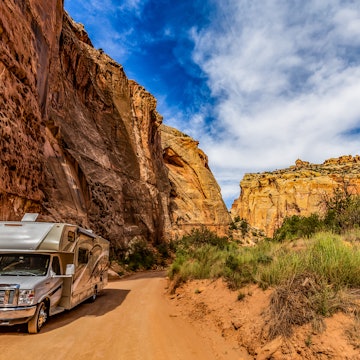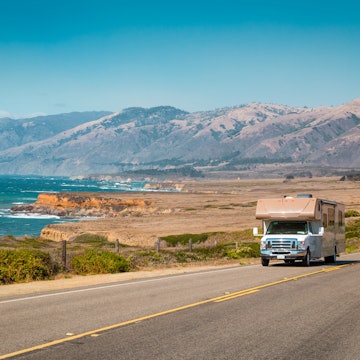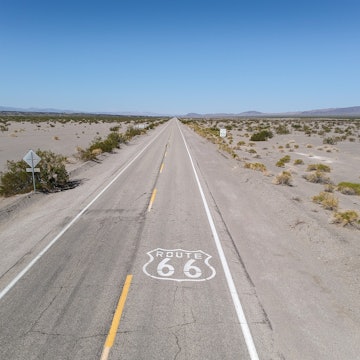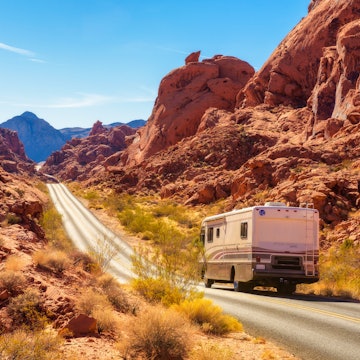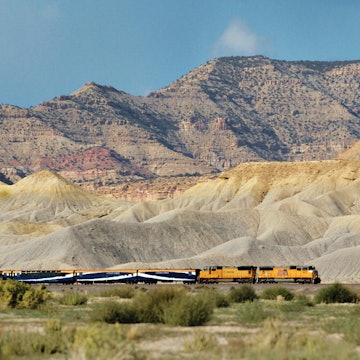
What it's like to ride the Rocky Mountaineer through Utah and Colorado

May 29, 2024 • 9 min read

Rocky Mountaineer's newest train service runs between Denver and Moab, Utah © Alexander Howard / Lonely Planet
“You’ve never seen Glenwood Canyon quite like this.” Over lunch in Salt Lake City, my guide Shawn Horman explains the singular experience of riding a train through one of Colorado’s most spectacular scenic drives.
“Glenwood is a nice drive,” he continues, referring to the swath of I-70 that snakes through the canyon. “But it’s pretty hectic – busy, winding around curves.” If you’re driving, he says, you have to keep your eyes on the road. On the train, you can sit back and relax and watch the mountains pass by.
I’m in Utah to board the Rockies to the Red Rocks train route, traveling from Moab to Denver. For the next two days, I'll travel over 350 miles through towering canyons, historic towns and desert buttes. It’s the only US route by Rocky Mountaineer, a Canada-based company that also runs train trips from Vancouver to spots like Whistler, Jasper and Banff in British Columbia. Known for its luxury services and glass-domed train cars, Rocky Mountaineer has run train routes in British Columbia since 1990.
What kind of excursions are there?
Shawn’s here to show me around Moab – he’s with Southwest Adventure Tours, an outfit that runs individual and group trips all around the Southwest US. Basic Rocky Mountaineer packages just include the train from Moab to Denver or reverse (from $1699 for the 2024 season), but passengers can purchase add-on excursions to sites like Arches National Park, Canyonlands or even to the Grand Canyon. From Salt Lake City, Shawn and I drive to Moab. A haze from wildfires out west lingers over the city skyline and surrounding Wasatch Mountains.

We spend the day wandering around Arches National Park. After over a decade of travel writing, I've gathered a few cliches to avoid and hack phrases to that come up when writing about special places – "otherworldly," "wonderland" and "surreal" just to name a few.
At Arches, these words all spring to mind. The landscape seems carved by hand, shaped to some blueprint designed to inspire awe. To think that it was simply the right mix of minerals, time and erosion that birthed these precariously balanced rocks, deep canyons and of course the eponymous sandstone arches boggles the mind.
The detour is an excellent start to the trip. With my boots dusted with red dirt, I feel ready to board the train and see more.
What's it like onboard?
The following afternoon, I arrive at the station, excited to see more of the scenery from the comfort of the train. As we board, I notice that the other passengers appear to be mostly retirees, although I do spot the occasional younger couple looking to see the Rockies from the comfort of a train car.
The car is spacious and comfortable. Reclining leather-like seats have plenty of legroom, and every one is a front-row view of the passing landscapes. Tall windows that curve up to the top of the car provide unobstructed views of even the route’s deepest canyons. Each seat has an electrical outlet, so I won't need to worry about maintaining a charge as I snap endless shots of the passing landscapes.

What's SilverLeaf and SilverLeaf Plus?
On the Rockies to the Red Rocks route, service is split between two classes: SilverLeaf and SilverLeaf Plus. The latter features access to a lounge car, which has additional seating and a full bar with a better beer and wine selection than found on the SilverLeaf car. The extra lounge car also has the effect of splitting the passengers between the two cars – once we’re off, most of the passengers head into the lounge for a drink, leaving much of the main car virtually empty. I take advantage of the emptiness to watch the terrain pass on both sides of the car.
Absent on this route is the GoldLeaf service, which is common on the Canada routes and features a two-level passenger car and a galley, where food is freshly prepared. The tunnels on the US route were too small to fit the GoldLeaf cars, so Rocky Mountaineer added the lounge car for its SilverLeaf Plus service, something unique to this route.

What's the food and drink like on the Rocky Mountaineer?
The lounge car buzzes with energy, serving as a social hub where passengers mingle over drinks. Canapés and a fresh caprese salad are precursors to our mains for dinner. Our onboard host, August, describes what's on the menu: a choice of roasted chicken breast with fire-roasted corn and poblano salsa, ale-braised short ribs with pearl onions and foraged mushrooms or a vegetarian option consisting of seasonal vegetables and roasted San Luis Valley potatoes.
The lack of a galley car means the food is prepared offsite and reheated on board. It’s not exactly airplane food, but it’s close. The catering service that Rocky Mountaineer contracts to prepare its dining experience also provides high-end private jet food in Denver. My roasted chicken is attractively plated, with the corn and poblano salsa layered over the chicken and a sprig of fresh rosemary on top. I'm pleasantly surprised.
For drinks, some of the areas best producers are represented. The drink list features wines from Colorado Cellars in Palisade, craft beers from Glenwood Springs and artisanal spirits from Woody Creek Distillery in Basalt, Colorado.
Where do you sleep?
This isn't a sleeper train. That evening, we arrive at the route's only stop: Glenwood Springs. A longtime travel destination known for its hot springs and access to the surrounding Rockies, Glenwood Springs has seen visitors like Al Capone, Doc Holliday and Teddy Roosevelt. The town has retained a bit of the Wild West vibe with its main street of low, brick buildings and saloons.

I head over to the Glenwood Hot Springs Resort to deposit my things before walking down to the hot springs pool, a gigantic swimming complex of one large heated mineral pool and a semi-heated lap pool. Steam rises into the air as night falls.
The pool is warm and huge. Children leap from the edge, and older kids take turns on the diving board. Prior to European arrival, the nomadic, hunter-gatherer Ute people utilized the area's natural hot springs for their restorative and healing effects, naming the spring Yampah or "big medicine." The Ute tribes revered the mineral-rich springs not only for their healing properties but also as a sacred gathering place for spiritual ceremonies and tribal meetings, underscoring their deep spiritual and physical connection to the landscape. In the mid-1800s, gold was discovered in Colorado, and white colonizers began to settle the area. The Utes entered into treaties with the US government, but were ultimately relocated to reservations in Utah and Southwest Colorado.
In the 1880s, a silver baron named Walter Devereux purchased the land surrounding the springs with the help of East Coast and British investors. In 1888 Devereux opened Glenwood Hot Springs, and it quickly became a popular destination for the elite seeking therapeutic benefits of its natural hot springs. It soon became a center of social and cultural activity, hosting lavish events as a gateway for explorers and miners venturing into the Rocky Mountains during Colorado's silver mining era.

Departing Glenwood Springs
The next day, I head out early to catch a glimpse of the train as it arrives in Glenwood Springs. Other passengers mill about, filling disposable cups with fresh coffee from a large thermos on a table outside the station. Moments later we hear the train horn blow, and the locomotive appears from behind a bend in the track. Passengers snap photos as the train squeals to a stop.
As we find our seats, August welcomes us aboard, saying there will be a minor delay while another train ahead cleared the tracks. Breakfast service would begin shortly; our options are a frittata or a golden waffle.
Breakfast arrives as the train travels through Glenwood Canyon. Stretching 16 miles along the track, Glenwood Canyon is one of the more spectacular scenes we pass through, with rock walls that reach more than 1300ft. The sky is clear save for a few small clouds, and the sun appears over the canyon ridge, bathing the brown cliffs in morning light.

As we leave the canyons and peaks of the Rocky Mountains and begin our descent down the Front Range, Denver’s skyline appears through the haze. I head out into the open-air vestibule connecting two cars, where it’s just me, the wind and the view. The train snakes down toward the city, and I think back to Shawn’s assurances that the view from the train is a special one.
Eventually we arrive in Denver, the train coming to a stop in the trendy River North Arts District (ambitions are to pull right into Denver’s historic Union Station, but agreements have not been finalized). The railyard is a dense collection of rails stretched out like sheet music ledger lines in each direction. Passengers load into coach buses that will take them to their hotels for the night. Construction cranes loom in the distance, paused for the weekend on a Friday night. It’s a fitting end to our journey, a future being built, after a brief delay. But still on track.

Which direction? Eastbound or Westbound?
Travelers on Rocky Mountaineer Rockies to Red Rocks have the option to travel either eastbound (from Moab to Denver) or westbound (from Denver to Moab). Both directions offer stunning views, but there are a few factors to consider when deciding which route to take.
Starting the journey in Moab has its advantages, such as the opportunity to explore the nearby Arches National Park before boarding the train. This breathtaking start sets the stage for the scenic journey ahead.
However, choosing to start in Denver also has its benefits. Denver is served by a major airport, making it more convenient for travelers flying in from other destinations. This can simplify your travel arrangements and reduce the need for additional transportation.
Moreover, if you plan to visit Arches or any of the other Utah national parks, pairing it with the westbound route from Denver to Moab can create a more dramatic and satisfying crescendo to the journey. After experiencing the stunning landscapes and historic towns along the train route, you'll arrive in Moab, ready to explore the unique geological wonders of Southwestern Utah.
Alexander Howard traveled to Utah and Colorado with support from Rocky Mountaineer. Lonely Planet contributors do not accept freebies in exchange for positive coverage.










